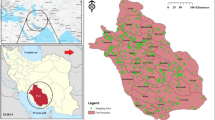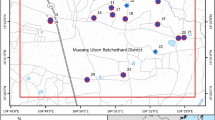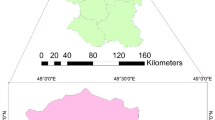Abstract
A study was conducted to explore the effect of arsenic causing conjunctivitis, neuropathy and respiratory illness in individuals, with or without skin lesions, as a result of exposure through drinking water, contaminated with arsenic to similar extent. Exposed study population belongs to the districts of North 24 Parganas and Nadia, West Bengal, India. A total of 725 exposed (373 with skin lesions and 352 without skin lesions) and 389 unexposed individuals were recruited as study participants. Participants were clinically examined and interviewed. Arsenic content in drinking water, urine, nail and hair was estimated. Individuals with skin lesion showed significant retention of arsenic in nail and hair and lower amount of urinary arsenic compared to the group without any skin lesion. Individuals with skin lesion also showed higher risk for conjunctivitis ((odd's ratio) OR: 7.33, 95% CI: 5.05–10.59), peripheral neuropathy (OR: 3.95, 95% CI: 2.61–5.93) and respiratory illness (OR: 4.86, 95% CI: 3.16–7.48) compared to the group without any skin lesion. The trend test for OR of the three diseases in three groups was found to be statistically significant. Again, individuals without skin lesion in the exposed group showed higher risk for conjunctivitis (OR: 4.66, 95% CI: 2.45–8.85), neuropathy (OR: 3.99, 95% CI: 1.95–8.09), and respiratory illness (OR: 3.21, 95% CI: 1.65–6.26) when compared to arsenic unexposed individuals. Although individuals with skin lesions were more susceptible to arsenic-induced toxicity, individuals without skin lesions were also subclinically affected and are also susceptible to arsenic-induced toxicity and carcinogenicity when compared to individuals not exposed to arsenic.
This is a preview of subscription content, access via your institution
Access options
Subscribe to this journal
Receive 6 print issues and online access
$259.00 per year
only $43.17 per issue
Buy this article
- Purchase on Springer Link
- Instant access to full article PDF
Prices may be subject to local taxes which are calculated during checkout


Similar content being viewed by others
References
Baidya K., Raj A., Mondal L., and Todani A. Persistent conjunctivitis associated with drinking arsenic contaminated water. J Occul Pharmacol TH 2006 (in press).
Basu A., Mahata J., Gupta S., and Giri A.K. Genetic toxicology of a paradoxical human carcinogen, arsenic: a review. Mutat Res 2001: 488 (2): 171–194.
Basu A., Mahata J., Roy A.K., Sarkar J.N., Poddar G., Nandy A.K., et al. Enhanced frequency of micronuclei in individuals exposed to arsenic through drinking water in West Bengal, India. Mutat Res 2002: 516: 29–40.
Basu A., Ghosh P., Das J.K., Banerjee A., Ray K., and Giri A.K. Micronuclei as biomarkers of carcinogen exposure in populations exposed to arsenic through drinking water in West Bengal, India: a comparative study in 3 cell types. Cancer Epidemiol Biomarkers Prev 2004: 13: 820–827.
Basu A., Som A., Ghoshal S., Mondal L., Chaubey R.C., Bhilwade H.N., et al. Assessment of DNA damage in peripheral blood lymphocytes of individuals susceptible to arsenic induced toxicity in West Bengal, India. Toxicol Lett 2005: 159: 100–112.
Benramdane L., Accominotti M., Fanton L., Malicier D., and Vallon J.J. Arsenic speciation in human organs following fatal arsenic trioxide poisoning-a case report. Clin Chem 1999: 45: 301–306.
Biggs M.L., Kalman D.A., Moore L.E., Hopenhayn-Rich C., Smith M.T., and Smith A.H. Relationship of urinary arsenic to intake estimates and a biomarker of effect, bladder cell micronuclei. Mutat Res 1997: 386 (3): 185–195.
Buchet J.P., Lauwerys R., and Roels H. Comparison of the urinary excretion of arsenic metabolites after a single dose of sodium arsenite, monomethylarsonate or dimethylarsinate in man. Int Arch Occup Environ Health 1981: 48 (1): 71–79.
Chakraborti D., Rahman M.M., Paul K., Chowdhury U.K., Sengupta M.K., Lodh D., et al. Arsenic calamity in the Indian subcontinent- What lessons have been learned? Talanta 2002: 58: 3–22.
Chatterjee A., Das D., Mandal B.K., Roy Chowdhury T., Samanta G., and Chakraborti D. Arsenic in ground water in six districts of West Bengal, India: the biggest arsenic calamity in the world I. Arsenic species in drinking water and urine of the affected people. Analyst 1995: 120: 643–650.
Chen C.J., Chen C.W., Wu M.M., and Kuo T.L. Cancer potential in liver, lung, bladder and kidney due to ingested inorganic arsenic in drinking water. Br J Cancer 1992: 66 (5): 888–892.
Chen C.J., Chuang Y.C., Lin T.M., and Wu H.Y. Malignant neoplasms among residents of a blackfoot disease-endemic area in Taiwan: high-arsenic artesian well water and cancers. Cancer Res 1985: 45: 5895–5899.
Chen H., Li S., Liu J., Diwan B.A., Barrett J.C., and Waalkes M.P. Chronic inorganic arsenic exposure induces hepatic global and individual gene hypomethylation: implications for arsenic hepatocarcinogenesis. Carcinogenesis 2004: 25: 1779–1786.
Das D., Chatterjee A., Mandal B.K., Samanta G., and Chakraborti D. Arsenic in groundwater in six districts of West Bengal, India: the biggest arsenic calamity in the world. II. Arsenic concentration in drinking water, hair, nails, urine, skin-scale and liver tissue (biopsy) of the affected people. Analyst 1995: 120: 917–924.
De Chaudhuri S., Mahata J., Das J.K., Mukherjee A., Ghosh P., Sau T.J., et al. Association of specific p53 polymorphisms with keratosis in individuals exposed to arsenic through drinking water in West Bengal, India. Mutat Res 2006 (in press).
Frost F.J., Muller T., Petersen H.V., Thomson B., and Tollestrup K. Identifying US populations for the study of health effects related to drinking water arsenic. J Expo Anal Environ Epidemiol 2003: 13 (3): 231–239.
Ghosh P., Basu A., Mahata J., Basu S., Sengupta M., Das J.K., et al. Cytogenetic damage and genetic variants in the individuals susceptible to arsenic-induced cancer through drinking water. Int J Cancer 2006: 118 (10): 2470–2478.
Guha Mazumder D.N. Chronic arsenic toxicity: clinical features, epidemiology, and treatment: experience in West Bengal. J Environ Sci Health A Tox Hazard Subst Environ Eng 2003: 38 (1): 141–163.
Guha Mazumder D.N., De B.K., Santra A., Ghosh N., Das S., Lahiri S., et al. Randomized placebo-controlled trial of 2,3-dimercapto-1-propanesulfonate (DMPS) in theray of chronic arsenicosis due to drinking arsenic-contaminated water. J Toxicol Clin Toxicol 2001: 39: 665–674.
Haque R., Mazumder D.N., Samanta S., Ghosh N., Kalman D., Smith M.M., et al. Arsenic in drinking water and skin lesions: dose-response data from West Bengal, India. Epidemiology 2003: 14: 174–182.
Hossain M.K., Khan M.M., Alam M.A., Chowdhury A.K., Delwar H.M., Feroze A.M., et al. Manifestation of arsenicosis patients and factors determining the duration of arsenic symptoms in Bangladesh. Toxicol Appl Pharmacol 2005: 208 (1): 78–86.
Kitchin K.T. Recent advances in arsenic carcinogenesis: modes of action, animal model systems, and methylated arsenic metabolites. Toxicol Appl Pharmacol 2001: 172: 249–261.
Mahata J., Basu A., Ghoshal S., Sarkar J.N., Roy A.K., Poddar G., et al. Chromosomal aberrations and sister chromatid exchanges in individuals exposed to arsenic through drinking water in West Bengal, India. Mutat Res 2003: 534: 133–143.
Mandal B.K., Roy Chowdhury T., Samanta G., Basu G.K., Chowdhury P.P., Chanda C.R., et al. Arsenic in ground water in seven districts of West Bengal, India-the biggest arsenic calamity in the world. Curr Sci 1996: 70: 976–986.
Mukherjee S.C., Rahman M.M., Chowdhury U.K., Sengupta M.K., Lodh D., Chanda C.R., et al. Neuropathy in arsenic toxicity from groundwater arsenic contamination in West Bengal, India. J Environ Sci Health Part A Tox Hazard Subst Environ Eng 2003: 38: 165–183.
Mazumder D.N., Haque R., Ghosh N., De B.K., Santra A., Chakraborti D., et al. Arsenic in drinking water and the prevalence of respiratory effects in West Bengal, India. Int J Epidemiol 2000: 29: 1047–1052.
Rahman M.M., Chowdhury U.K., Mukherjee S.C., Mondal B.K., Paul K., Lodh D., et al. Chronic arsenic toxicity in Bangladesh and West Bengal, India-a review and commentary. J Toxicol Clin Toxicol 2001: 39 (7): 683–700.
Shimizu M., Hochadel J.F., Fulmer B.A., and Waalkes M.P. Effect of glutathione depletion and metallothionein gene expression on arsenic-induced cytotoxicity and c-myc expression in vitro. Toxicol Sci 1998: 45: 204–211.
Tseng W.P. Effects and dose-response relationships of skin cancer and blackfoot disease with arsenic. Environ Health Perspect 1977: 19: 109–119.
WHO. Guidelines for Drinking Water Quality, 2nd ed. Vol. 2. Health criteria and other supporting information, Geneva, 1996 pp 940–949.
Wu M.M., Kuo T.L., Hwang Y.H., and Chen C.J. Dose-response relation between arsenic concentration in well water and mortality from cancers and vascular diseases. Am J Epidemiol 1989: 130 (6): 1123–1132.
Acknowledgements
The authors are grateful to the Council of Scientific and Industrial Research (CSIR), Government of India for funding the study (project no. CMM 003) and for providing research fellowships to PG, MB, SDC and RC.
Author information
Authors and Affiliations
Corresponding author
Rights and permissions
About this article
Cite this article
Ghosh, P., Banerjee, M., De Chaudhuri, S. et al. Comparison of health effects between individuals with and without skin lesions in the population exposed to arsenic through drinking water in West Bengal, India. J Expo Sci Environ Epidemiol 17, 215–223 (2007). https://doi.org/10.1038/sj.jes.7500510
Received:
Accepted:
Published:
Issue Date:
DOI: https://doi.org/10.1038/sj.jes.7500510
Keywords
This article is cited by
-
Association of ABCC4 G559T single nucleotide polymorphism with arsenic-induced precancerous hyperkeratosis
The Nucleus (2023)
-
Recent advances in field-effect transistors for heavy metal ion detection
Journal of Materials Science: Materials in Electronics (2022)
-
Dynamic alteration in miRNA and mRNA expression profiles at different stages of chronic arsenic exposure-induced carcinogenesis in a human cell culture model of skin cancer
Archives of Toxicology (2021)
-
Biosorptive removal of arsenite and arsenate from aqueous medium using low-cost adsorbent derived from ‘Pods of green peas’: Exploration of kinetics, thermodynamics and adsorption isotherms
Korean Journal of Chemical Engineering (2018)
-
Arsenic toxicity and epimutagenecity: the new LINEage
BioMetals (2017)



